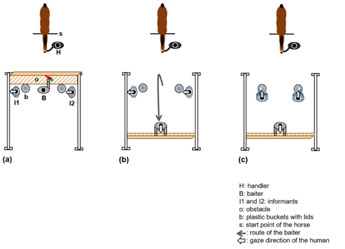Published: August 10, 2021
Open Access
Horses with sustained attention follow the pointing of a human who knows where food is hidden
Monamie Ringhofer, Miléna Trösch, Léa Lansade, Shinya Yamamoto
Full Text
Figure3: Schematic representation of the test trial. (a) When the baiter shows the carrot to the horse. (b) When the baiter removes the obstacle and goes into the middle and behind the informants. (c) When the two informants go behind the buckets and make choices by pointing at each bucket. Here, I1 acts as a guesser and I2 acts as a knower.
Abstract
When interacting with humans, domesticated species may respond to communicative gestures, such as pointing. However, it is currently unknown, except for in dogs, if species comprehend the communicative nature of such cues. Here, we investigated whether horses could follow the pointing of a human informant by evaluating the credibility of the information about the food-hiding place provided by the pointing of two informants. Using an object-choice task, we manipulated the attentional state of the two informants during food-hiding events and differentiated their knowledge about the location of the hidden food. Furthermore, we investigated the horses' visual attention levels towards human behaviour to evaluate the relationship between their motivation and their performance of the task. The result showed that horses that sustained high attention levels could evaluate the credibility of the information and followed the pointing of an informant who knew where food was hidden (Z = − 2.281,
P = 0.002, n = 36). This suggests that horses are highly sensitive to the attentional state and pointing gestures of humans, and that they perceive pointing as a communicative cue. This study also indicates that the motivation for the task should be investigated to determine the socio-cognitive abilities of animals.
Article Information
Ringhofer, M., Trösch, M., Lansade, L., & Yamamoto, S.(2021)Horses with sustained attention follow the pointing of a human who knows where food is hidden Scientific Reports
, 11, 16184
10.1038/s41598-021-95727-8